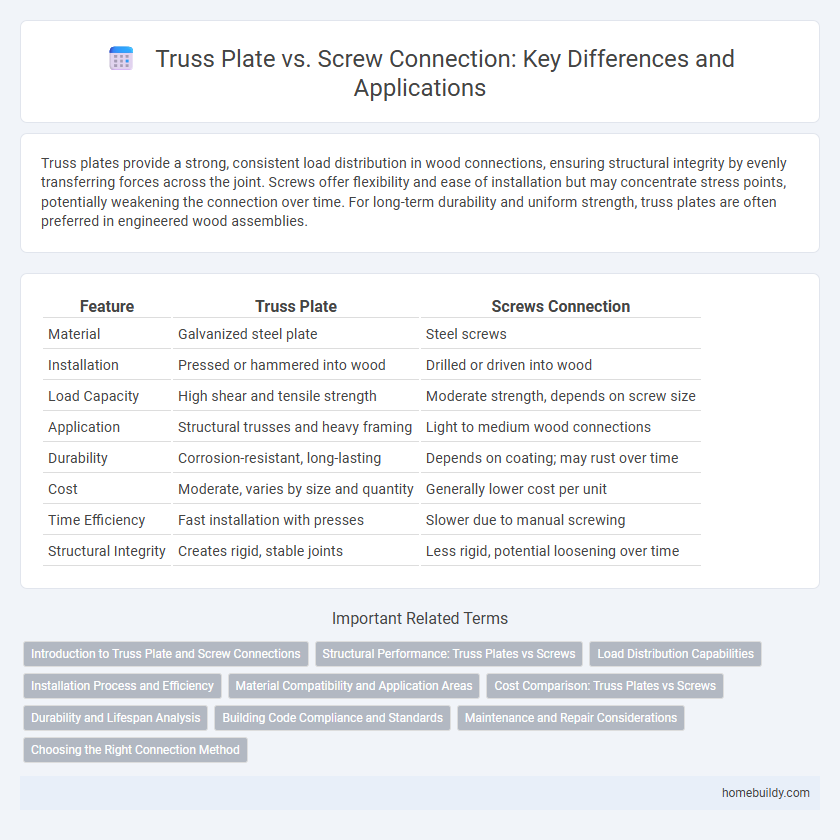Truss plates provide a strong, consistent load distribution in wood connections, ensuring structural integrity by evenly transferring forces across the joint. Screws offer flexibility and ease of installation but may concentrate stress points, potentially weakening the connection over time. For long-term durability and uniform strength, truss plates are often preferred in engineered wood assemblies.
Table of Comparison
| Feature | Truss Plate | Screws Connection |
|---|---|---|
| Material | Galvanized steel plate | Steel screws |
| Installation | Pressed or hammered into wood | Drilled or driven into wood |
| Load Capacity | High shear and tensile strength | Moderate strength, depends on screw size |
| Application | Structural trusses and heavy framing | Light to medium wood connections |
| Durability | Corrosion-resistant, long-lasting | Depends on coating; may rust over time |
| Cost | Moderate, varies by size and quantity | Generally lower cost per unit |
| Time Efficiency | Fast installation with presses | Slower due to manual screwing |
| Structural Integrity | Creates rigid, stable joints | Less rigid, potential loosening over time |
Introduction to Truss Plate and Screw Connections
Truss plates are metal connectors used to join wooden components in structural frameworks, providing strong, durable, and efficient load transfer. Screw connections offer versatile fastening with ease of installation and adjustability but may require more maintenance in heavy-load applications. Comparing truss plates and screw connections highlights differences in strength, reliability, and usage in building design and construction.
Structural Performance: Truss Plates vs Screws
Truss plates provide superior structural performance compared to screws by distributing loads evenly across joints through their large bearing surface area, which enhances stiffness and reduces localized stress concentrations. Screws, while easier to install, often result in point-load stress that can weaken timber fibers and compromise joint integrity under dynamic or heavy loads. The engineered design of truss plates ensures higher load capacity and durability in timber frame connections, making them preferable for structural applications requiring long-term reliability.
Load Distribution Capabilities
Truss plates provide superior load distribution capabilities compared to screws by evenly spreading forces across a larger surface area, reducing stress concentrations at connection points. The steel composition and serrated teeth of truss plates create a strong mechanical interlock with wooden members, enhancing joint stability under heavy loads. In contrast, screws concentrate load at discrete points, which can lead to localized weakening and potential failure under high stress conditions.
Installation Process and Efficiency
Truss plates offer a faster installation process compared to screws, as they can be quickly hammered or pressed into place without the need for drilling or aligning multiple fasteners. This efficiency reduces labor time and ensures consistent load distribution across the connection, enhancing structural integrity. Screws require precise placement and longer installation times, potentially increasing project costs and complexity.
Material Compatibility and Application Areas
Truss plates, typically made from galvanized steel, offer superior material compatibility with wooden structures by providing corrosion resistance and uniform load distribution, whereas screws may encounter compatibility issues depending on the wood type and environmental conditions. Truss plates are ideal for large-scale truss assemblies in construction and industrial applications where strong, permanent joints are required, while screws are better suited for smaller, adjustable connections in light-framing or repair tasks. Material strength and durability make truss plates preferable in structural applications demanding high shear capacity and long-term reliability.
Cost Comparison: Truss Plates vs Screws
Truss plates generally offer a more cost-effective solution compared to screws due to lower material and installation expenses, especially for large-scale projects. Screws, while providing higher adjustability and precision, tend to increase overall costs because of their higher price per unit and longer labor time. For budget-sensitive construction, truss plates often represent the most economical choice without compromising structural integrity.
Durability and Lifespan Analysis
Truss plates offer superior durability compared to screws due to their ability to distribute loads evenly across the joint, reducing stress concentrations that lead to premature failure. The lifespan of truss plate connections typically exceeds that of screw connections, as the galvanized steel plates resist corrosion and maintain structural integrity under fluctuating environmental conditions. In contrast, screws are prone to loosening and corrosion over time, which compromises the connection stability and reduces overall service life.
Building Code Compliance and Standards
Truss plates offer superior building code compliance compared to screws due to their engineered design and standardized manufacturing processes, ensuring consistent load distribution and structural integrity. Building codes such as the International Building Code (IBC) and standards like the American Society for Testing and Materials (ASTM) specifically recognize metal truss plates for their proven performance in wood truss connections. In contrast, screws typically lack such standardized evaluation and certification, often requiring additional engineering approval to meet code requirements for structural applications.
Maintenance and Repair Considerations
Truss plates offer a low-maintenance connection due to their embedded design, which resists corrosion and minimizes loosening over time compared to screws. Screws require regular inspection and tightening to prevent loosening caused by vibration or wood shrinkage, increasing maintenance efforts. Repairing truss plates often involves partial replacement of affected components, whereas screw connections can be repaired by simply retightening or replacing fasteners.
Choosing the Right Connection Method
Truss plate connections provide superior load distribution and structural integrity by using galvanized steel plates that are pressed into timber joints, ensuring high shear resistance and durability. Screws offer easier installation and adjustability but may lack the same strength and long-term stability under heavy loads or dynamic forces. Selecting the right connection method depends on project requirements such as load capacity, environmental exposure, installation speed, and long-term maintenance considerations.
Truss plate vs Screws connection Infographic

 homebuildy.com
homebuildy.com